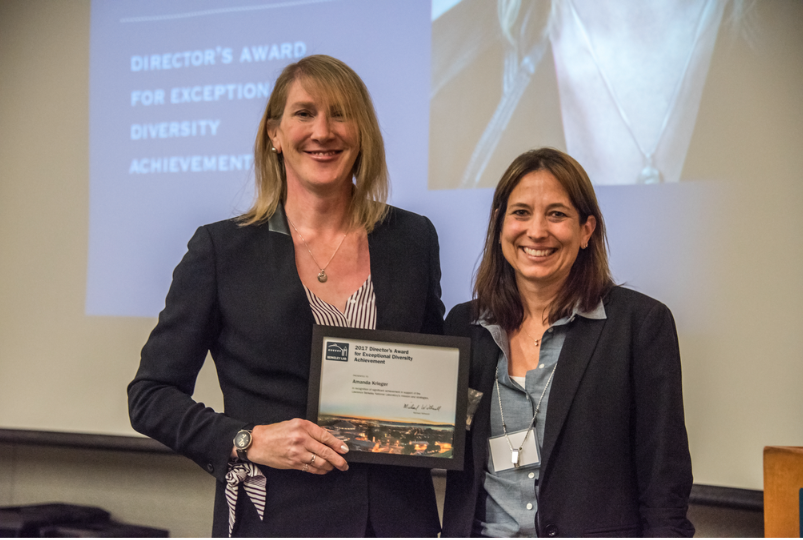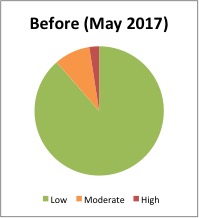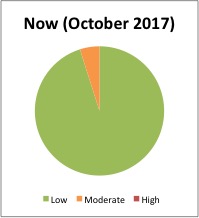Amanda Krieger, Director’s Award for Exceptional Achievement in Diversity (2017)
 Amanda Krieger, Engineering Division IC Design Engineer, was awarded the 2017 Director’s Award for Exceptional Achievement in Diversity. The Director’s Awards program recognizes significant achievements of Lab employees. Each year, these awards are given for accomplishments, leadership, collaboration, multi-disciplinary science, cross-divisional projects, and commitment to excellence in support of the Lab’s mission and strategic goals. Amanda is recognized for mentoring and leadership roles promoting diversity, and specifically “for her promotion of LGBTQ inclusion at Berkeley Lab, for her work to make the Lab a welcoming workplace for people of all communities, and her efforts to raise awareness of the Lab’s progress in diversity and inclusion.” More>
Amanda Krieger, Engineering Division IC Design Engineer, was awarded the 2017 Director’s Award for Exceptional Achievement in Diversity. The Director’s Awards program recognizes significant achievements of Lab employees. Each year, these awards are given for accomplishments, leadership, collaboration, multi-disciplinary science, cross-divisional projects, and commitment to excellence in support of the Lab’s mission and strategic goals. Amanda is recognized for mentoring and leadership roles promoting diversity, and specifically “for her promotion of LGBTQ inclusion at Berkeley Lab, for her work to make the Lab a welcoming workplace for people of all communities, and her efforts to raise awareness of the Lab’s progress in diversity and inclusion.” More>
Qiang Du, Early Career Research Program Award (2017)
 Qiang Du of the Engineering Division’s Electronics Engineering and Controls Group was among five scientists to be selected for the 2017 Early Career Research Program Award. Du’s award was titled “Scalable control of multidimensional coherent pulse addition for high average power ultrafast lasers”. The project was selected by the Office of High Energy Nuclear Physics and he will be working with the Accelerator Technology and Applied Physics Division. For this project, Du will “design, build, and demonstrate a scalable distributed digital stabilization control system for robust multidimensional coherent combining of ultrafast fiber lasers, and make it available as a general toolbox in ultrafast optics control. High average power ultrafast lasers are essential tools that support fundamental science and applications.” . More >
Qiang Du of the Engineering Division’s Electronics Engineering and Controls Group was among five scientists to be selected for the 2017 Early Career Research Program Award. Du’s award was titled “Scalable control of multidimensional coherent pulse addition for high average power ultrafast lasers”. The project was selected by the Office of High Energy Nuclear Physics and he will be working with the Accelerator Technology and Applied Physics Division. For this project, Du will “design, build, and demonstrate a scalable distributed digital stabilization control system for robust multidimensional coherent combining of ultrafast fiber lasers, and make it available as a general toolbox in ultrafast optics control. High average power ultrafast lasers are essential tools that support fundamental science and applications.” . More >
Ergo Improvements Make Positive Impact
In FY17, computer ergonomic (ergo) exposure was the second highest recordable injury, accounting for 22% of the Laboratory’s recordable injuries. To address this problem head on, the Engineering Division Ergo Advocate Team has implemented a proactive approach to reducing ergo risks in the division.
 Each week since June, the ergo duo, Eva Pan and Marshall Granados, review ergonomics reports to prioritize and target employees identified as high and moderate risk for ergonomic injury. Starting with the individuals at the highest risk level and with the highest number of ergo issues, they initially conduct drop-in visits for a casual ergo safety discussion and to offer recommendations to reduce ergo risk. Working as a team, they are able to discuss issues with the employee, make and document observations, and make workstation adjustments during the visit. If a drop-in visit proves to be ineffective or inconvenient, they calendar a formal meeting with the employee. Each employee is visited at least twice to offer recommendations and monitor progress towards implementation and improvement of fatigue or discomfort.
Each week since June, the ergo duo, Eva Pan and Marshall Granados, review ergonomics reports to prioritize and target employees identified as high and moderate risk for ergonomic injury. Starting with the individuals at the highest risk level and with the highest number of ergo issues, they initially conduct drop-in visits for a casual ergo safety discussion and to offer recommendations to reduce ergo risk. Working as a team, they are able to discuss issues with the employee, make and document observations, and make workstation adjustments during the visit. If a drop-in visit proves to be ineffective or inconvenient, they calendar a formal meeting with the employee. Each employee is visited at least twice to offer recommendations and monitor progress towards implementation and improvement of fatigue or discomfort.
Since the implementation of this new approach to ergo risk management, high risk ergo instances have been eliminated and moderate instances have been reduced by 46%. Out of 245 employees, the percentage of low risk employees has increased from 89% to 95%. The team continues initiate contact and work with the remaining 5% of employees who remain at the moderate risk level, some of which have chronic ergo issues that are being actively managed.
Not only have the numbers improved, but actively managing ergo risks has also had a positive effect on employee morale. Employees have expressed appreciation that their well-being is being considered. One employee stated, “I’m not used to people caring about me, only my output and the work that I do.”
While doing an assessment, the ergo duo discovered that the ergo risk they were assessing for one employee actually impacted the entire control room used by several employees in multiple divisions. Six workstations used the same obsolete, unadjustable chairs that required users to hunch to perform their work. In some cases, the employees spent more time at these workstations than they spent at their desks. In result of actions prompted by the initial ergo assessment of one employee, all six workstations are scheduled to be upgraded to current ergo standards, eliminating the ergo hazard for the group.
Though this project began as a way to reduce the ergo risk in the division, the benefits have reached beyond what was anticipated. The team approach promotes continuous progress and the partner-accountability helps to maintain consistency. Additionally, safety and morale of employees has improved and spills over into adjacent workspaces. With this new proactive approach to managing ergo risks, we hope to eliminate preventable ergonomic injuries in the division.
Schedule Photo Session
Engineering Division employees are encouraged to get a head shot taken. Employee photos are used for various purposes including: photo boards, seating charts, org charts, presentations, etc. Use the link below to schedule an appointment to have your photo taken.
Qualified Electrical Worker (QEW) Support
Qualified Electrical Worker Support:
The Engineering Division has QEWs designated to assist with the fabrication, modification and repair of Laboratory electrical equipment in accordance with our Electronic Equipment Build Standards. Schedule the support of a QEW via one of the following methods:
- Complete request form: https://app.smartsheet.com/b/form?EQBCT=cb6e45c71893442b9f614aa731513f11
- Email request to: qewhelp@lbl.gov
- Call x6222
- All Berkeley Lab unlisted (not UL or NRTL approved) electrical equipment must be inspected and approved before it can be used.
- All LBNL fabricated or modified listed electrical equipment must be inspected and approved before it can be used.
- See PUB 3000, Chapter 14 for details about Berkeley Lab’s Electrical Equipment Safety Program.
- Schedule an inspection BEFORE using unlisted or modified equipment via email: eesp@lbl.gov
___________
Background:
On October 13th, 2014 the Berkeley Lab Director wrote Division Directors and Division Deputies to emphasize the importance of electrical safety in the conduct of scientific research.
The Laboratory continues to expect that all staff understand and employ these fundamental electrical safety practices:
- Do not perform any electrical work
- Report unsafe equipment to your supervisor
- Enlist the support of a Qualified Electrical Worker (QEW) for all electrical work
- Lockout and Test Before Touch
- Establish and control the workspace
- Plan and control the work
- Correct unsafe behaviors and conditions


